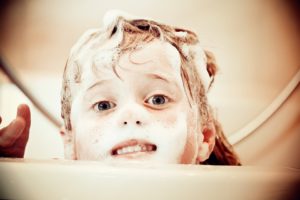Dandruff is a very well-known problem and considered common among young people, adults, and even children. Considered both a health and aesthetic issue, dandruff is not contagious and can be easily treated and controlled. But today we are going to talk about children with dandruff, its causes, care, and how to treat the problem.
What is Dandruff?
Dandruff is flaking of the scalp in the form of small white flakes that can be of various sizes1. Because it is very common, few people know its exact causes. Many children may suffer from extensive dandruff due to the use of certain types of shampoos, conditioners, or even leave-in creams2. If this is the cause, it can easily be resolved by changing the products used and switching to neutral products or those designed to combat dandruff. It’s important to point out that children should use products specifically made for pediatric use, and anti-dandruff shampoos are not always recommended for children. That’s why we always recommend talking with a pediatrician or a pediatric dermatologist.
Main Causes of Dandruff
One of the main causes of dandruff in children is individual skin tendency. Another important point is periods of stress, which can cause flaking of the scalp. Children going through exams or emotionally turbulent phases may have intense dandruff episodes. Periods of cold or very dry weather increase the chances of dandruff appearing in children. Certain hair care habits can also make the scalp oilier, such as going to bed with wet hair or overusing hair creams.
Washing Hair at Night
Ideally, whenever you wash hair at night, dry it with a hairdryer. This will prevent the scalp from becoming oily and flaky, which can cause lots of dandruff all over the scalp. Usually, a child with dandruff is blamed for lack of care, but it’s not always due to poor hygiene. Even with regular washing, dandruff can appear due to various factors. Dandruff is not related to a lack of hair cleanliness! The scalp itself and body temperature are linked to the appearance of dandruff, as is wearing hats, which creates a “trapped heat” on the scalp. These are the main causes of dandruff.
Dermatitis
In some cases, dandruff can also be caused by certain diseases, such as dermatitis, which is very common in babies and children3. So moms and dads, don’t worry — everything can be resolved with time or with some very simple care. If the problem persists, seek your pediatrician or a pediatric dermatologist for appropriate treatment. 
Dandruff Treatment for Children
The initial treatment for a child with dandruff is always to change the product that may be causing it. Avoiding going too long without washing the hair can also help, as increased scalp oiliness raises the chances of dandruff appearing. Dandruff not only looks bad, but it also causes a lot of itching. That’s why it’s recommended to wash the hair every other day, gently washing with the fingertips without scrubbing to avoid more flaking.
Shampoo for Dry Hair
Shampoos for dry hair may seem attractive for those who want to solve scalp oiliness, but they have a base of aluminum starch, which helps absorb oil and improve hair shine, but they do not solve or treat the dandruff problem and may even make it worse in some cases.
Baby With Dandruff
In the case of a baby with dandruff, with the help of an oil appropriate for babies and a cotton pad, you can apply it to the area and carefully remove dandruff with a comb. For older children with a lot of hair, changing the product, avoiding applying conditioner to the scalp, and keeping up regular washing will solve the problem.
Healthy Diet
Dandruff treatment for children also involves diet, since our bodies react to everything we eat. In some cases, dandruff may worsen due to a lack of vitamins in the body, so we recommend a balanced, nutritious, and healthy diet. Before you start any dandruff treatment for children, observe what might be causing it. Besides hygiene products, it can also occur due to hormonal changes, scalp oiliness, or even a genetic factor. If none of the tips mentioned solve the dandruff case in the child, it is best to see a scalp specialist who will evaluate the situation, request any necessary tests, and recommend the ideal treatment. See Also: How to Remove Cradle Cap in Babies? Photo: Pezibear











